This post contains affiliate links.
Uncover the astonishing speed of hummingbirds with insights from a seasoned enthusiast. Explore how these aerial acrobats achieve remarkable flight speeds and delve into the dynamics of their rapid wing movements.
Welcome fellow hummingbird enthusiasts! Have you ever gazed in wonder at the blur of a hummingbird’s wings and pondered just how swiftly these iridescent aviators soar through the skies?
In this article, we will unlock the secrets behind the impressive speeds of hummingbirds. We will delve into their awe-inspiring flight capabilities, exploring not only how fast they can fly, but also the factors that contribute to their unparalleled aerial agility. Prepare to be amazed as we reveal the true velocity of these remarkable creatures in the avian world.
Discovering How Fast Hummingbirds Can Fly
With an intrinsic fascination for these aerial acrobats of the bird world, I have spent considerable time uncovering the nuances of how fast hummingbirds can fly. In essence, when pondering the dynamics of hummingbird flight, one can not help but inquire, “how fast do hummingbirds fly?”
These diminutive birds, despite their petite size, exhibit remarkable speed and agility. When in a straight-line pursuit, hummingbirds can achieve astonishing speeds that leave many bird enthusiasts in awe. Just how fast can a hummingbird fly? During their normal flight, hummingbirds fly at an average speed of around 25-30 miles per hour. This is merely a fraction of their capability.
During courtship dives, a hummingbird reaches speeds that are quite astounding. When a male is performing his elaborate plunge to impress a potential mate, the bird’s velocity surge, and the hummingbird clock speeds of up to 60 miles per hour.
Read my article: Hummingbird Parents: (Mating to Nesting)
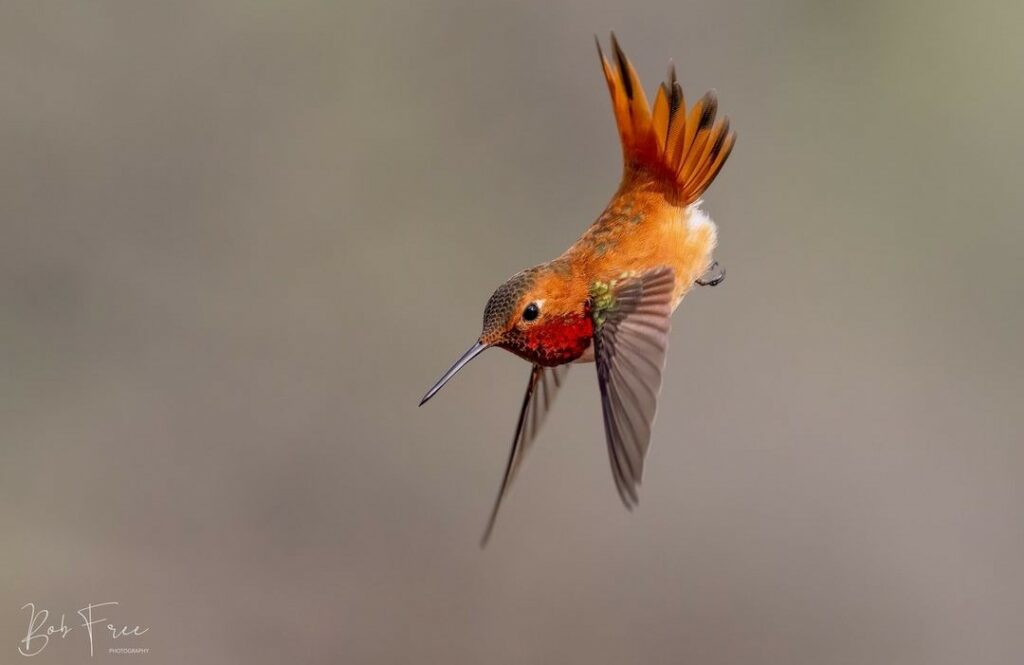
Photo by: Bob Free
This is a testament to how fast these birds are capable of flying, which highlights the sheer power and adaptability concealed within their delicate frames. It is no wonder bird lovers remain captivated by the spectacle of hummingbirds in flight.
The very question of “how fast can hummingbirds fly” evokes delight and curiosity. The answer ties into understanding the intense metabolic demands placed on a hummingbird’s body. Their rapid wingbeats, which exceed up to an incredible 50-80 beats per second, enable hummingbirds to hover and perform swift maneuvers unlike any other bird species.
This unique feature of hummingbirds flying is enhanced by their specialized wing structure which allows for a figure-eight pattern, resulting in unparalleled speed and agility in the air.
It is not about how fast these birds zip through the skies; their ability to suddenly stop and change direction is equally impressive. It is a spectacle that makes one appreciate the intricate ballet of hummingbirds flying. Their strong, yet lightweight skeletal structure aids them in sustaining their energetic lifestyle.
For an aficionado like myself who has been observing and admiring these creatures for over a decade and a half, it is clear that the hummingbird’s flight capabilities are an evolutionary marvel.
Hummingbirds can not only fly forwards but also upwards, downwards, and even momentarily float in reverse. This remarkable aspect of their flight emphasizes their adaptability and the unique niche hummingbirds have carved in the natural world.
Whether it is understanding the speed of a hummingbird’s flight or marveling at the way a hummingbird can fly, these birds continue to be a splendid enigma—one that I, alongside fellow enthusiasts, relish in unraveling year after year.
Understanding the Flight Speed and Mechanics of How Fast Hummingbirds Fly
For enthusiasts eager to uncover the secrets of how fast hummingbirds can fly, it is an enthralling quest teeming with aerodynamic wonders. These diminutive avians are a marvel when it comes to aerial speed, and their abilities in flight are nothing short of spectacular. It is intriguing to learn how fast they can go, considering the dizzying acrobatics they perform in the blink of an eye.
When talking about the speed hummingbirds fly, consider different modes of flight. When they are merely commuting from flower to flower and not in a hurry, their speed averages approximately 30-45 mph.
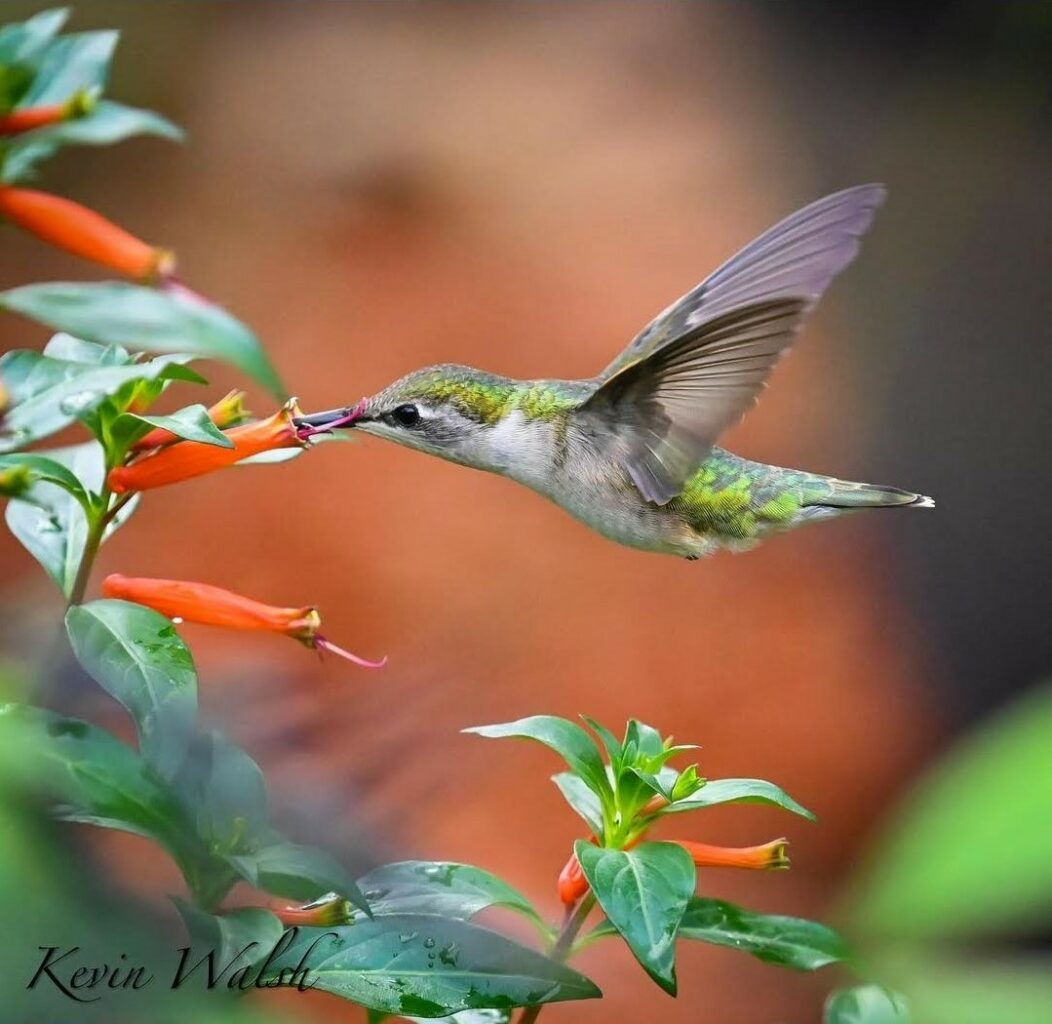
Cigar Plant – (Cuphea ignea)
Photo by: Kevin Walsh
When the situation is in demand, for instance, during a chase or an escape, their speed increases significantly. Hummingbirds will beat their wings up to an astonishing 80 times per second, which propels them even faster.
Read my article: Why Do Hummingbirds Chase Each Other: Is It Friend Or Foe
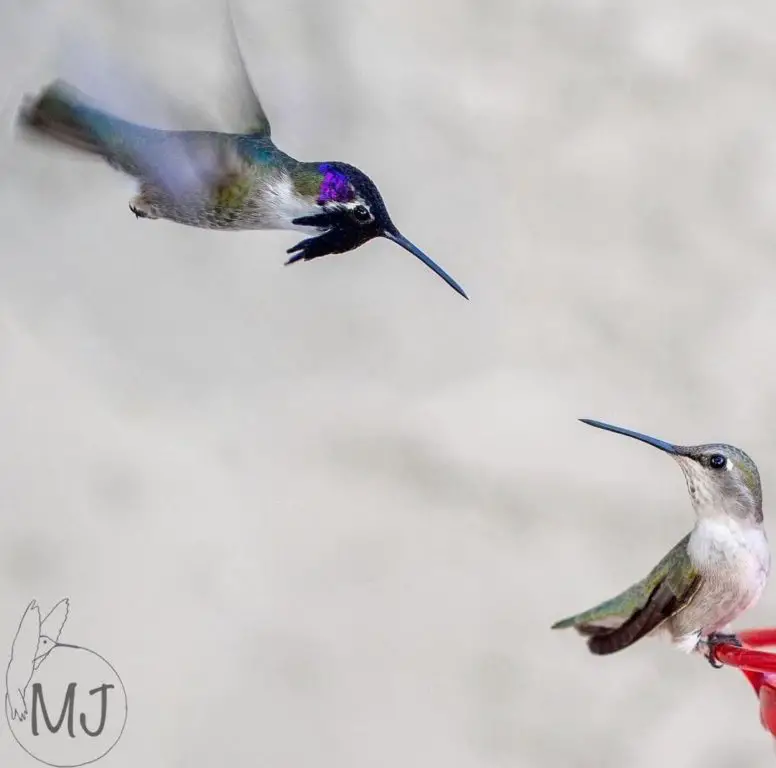
Photo by: hummingbirdsbysuprise
During courtship displays or territorial dives, a hummingbird can reach speeds that are truly quick, plummeting from heights like a missile. Studies have shown that in these high-stakes maneuvers, hummingbirds can dive at speeds that exceed 50 mph. For instance, the Anna’s hummingbird has been recorded diving at speeds of up to 60 miles per hour (97 kilometers per hour).
Their small size belies the power contained within those active bodies – their speed is a testament to this. In a tail chase, the pursuer and the pursued zip through the air, showcasing just how fast and agile these creatures are, turning flying into a thrilling display of aerobatic proficiency.
The speed at which hummingbirds fly is not just about raw pace; it is a complex ballet of physics and physiology. When hummingbirds beat their wings, they do not just flap up and down; they rotate their wings in a figure-eight motion, which provides lift and thrust simultaneously. This ingenious flight mechanism underscores how hummingbirds fly with the power and grace that fascinate onlookers.
Their flying prowess raises the question: how fast can hummingbirds fly outright, when speed is their sole objective? Well-informed estimates place their top speed during flight at around 60 mph under ideal conditions. Speed varies with species, health, and environmental factors.
In summarizing how fast hummingbirds fly, it is crucial to appreciate both the speed of their wingbeats and the velocity of their overall flight. This quick, iridescent beauty of the avian world has evolved to fly at remarkable speeds, vital for foraging and defense. Their flying is an intricate dance between energy, agility, and the laws of physics, as is evident when you watch a hummingbird zip through the air.
It is a true testament to what these aerial dynamos can perform. When we ponder over how fast they can go, it is not an exaggeration to say that hummingbirds’ flight puts them in a league of their own, captivating us with every quick, precise movement.
Below is a sampling list of hummingbird wingbeat speeds in order of frequency from highest to lowest:
- Ruby-throated Hummingbird (Archilochus colubris): up to 80 wingbeats per second
- Anna’s Hummingbird (Calypte anna): about 70 wingbeats per second
- Violet-crowned Hummingbird (Amazilia violiceps): approximately 60-70 wingbeats per second
- Blue-throated Mountain-gem (Lampornis clemenciae): around 50 wingbeats per second
- Broad-tailed Hummingbird (Selasphorus platycercus): around 40-50 wingbeats per second
- Rufous Hummingbird (Selasphorus rufus): about 40-50 wingbeats per second
- Allen’s Hummingbird (Selasphorus sasin): roughly 50 wingbeats per second
- Magnificent Hummingbird (Eugenes fulgens): approximately 40-45 wingbeats per second
- White-eared Hummingbird (Hylocharis leucotis): around 35-45 wingbeats per second
- Buff-bellied Hummingbird (Amazilia yucatanensis): about 35 wingbeats per second
Examining the High-Speed Flight of Hummingbirds: How Do They Sustain Energy?
Among the avian world’s most picturesque marvels, hummingbirds characterize the pinnacle of evolution when it comes to aerodynamics and energy efficiency. The remarkable speed at which hummingbirds fly commands attention from researchers and enthusiasts alike. How fast can a hummingbird fly? While darting about gardens and feeders, a hummingbird can clock speeds ranging from 15 to 30 mph, which is undeniably fast for an organism of such diminutive stature.
During courtship dives, they reach velocities even faster; male hummingbirds are documented soaring at a breathtaking 60 mph, a velocity that showcases their prowess and agility. It is not merely about how fast these birds fly but also about how hummingbirds sustain their renowned consistent, high-speed flight.
The secret to their energetic prowess lies in their physiology, specifically, the incredibly high metabolic rate that enables them to beat their wings at the astonishing rate of up to 80 times per second!
Their flight muscles are rich in mitochondria, furnishing them with a continuous burst of power. During migration—a relentless journey that can span up to 500 miles non-stop across the Gulf of Mexico—hummingbirds conserve energy by slipping into a torpor-like state at night to save precious calories. This type of hibernation is a physiological marvel, allowing them to store the energy they will demand for the next day’s flight.
To keep their tiny engines running, these birds consume nectar, their primary source of fuel, which acts as high-octane energy for flight. They also require protein which they get from insects, converting this into muscle that is essential for flight. Their food foraging pattern is a spectacle of speed and precision, showcasing just how fast a hummingbird can maneuver in pursuit of sustenance.
Read my article: Do Hummingbirds Eat Mosquitoes?
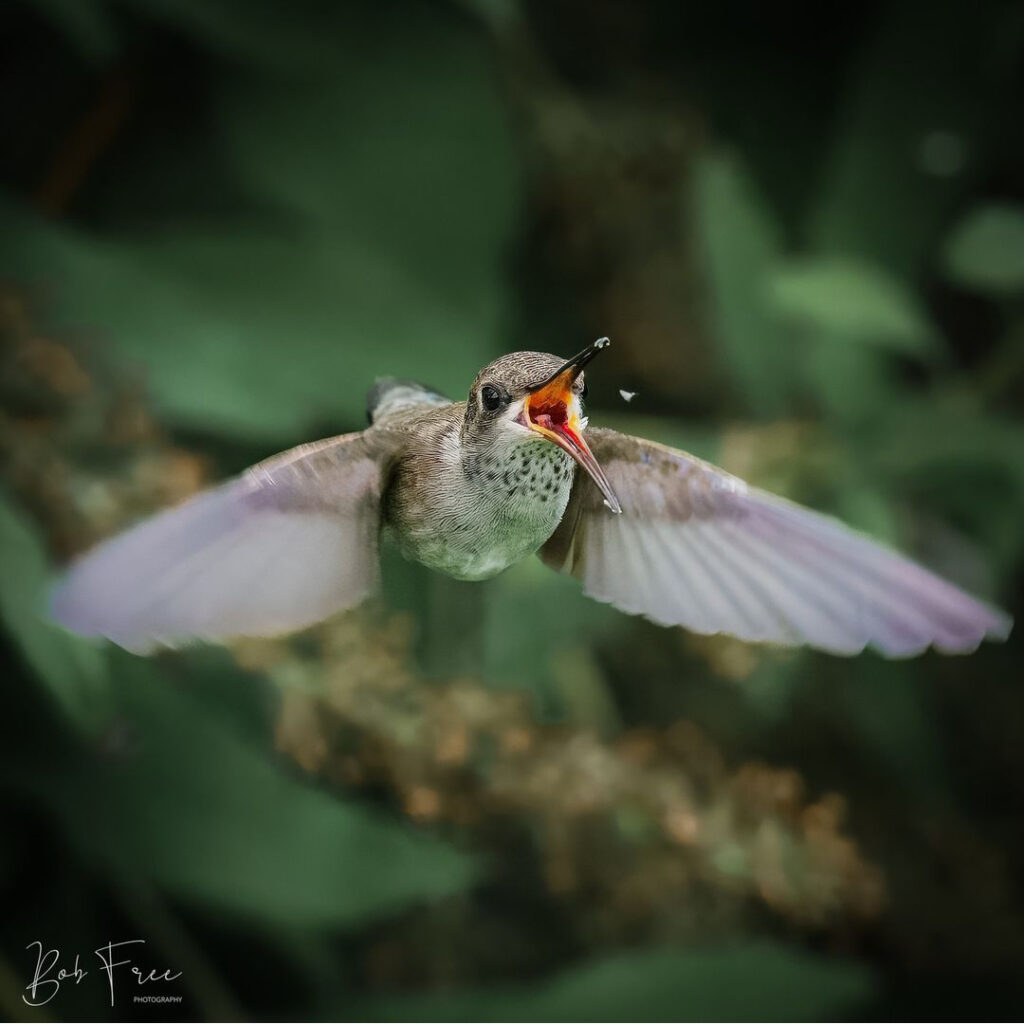
Photo by: Bob Free
It is crucial to note that when we talk about how fast hummingbirds can fly, we are also referring to their incredible wing speed, a facet that distinguishes their flight mechanics from other birds.
Rest is equally as important for maintaining their flight capabilities. Finding a balance between rest and activity is key.
Hummingbirds perch to conserve energy between feedings or when scrutinizing over their territory, belying the relentless energy that underpins their existence. Observing these birds, one wonders how such a fast-flying creature manages to maintain their energy levels, but evolution has made them masters of metabolism and flight.
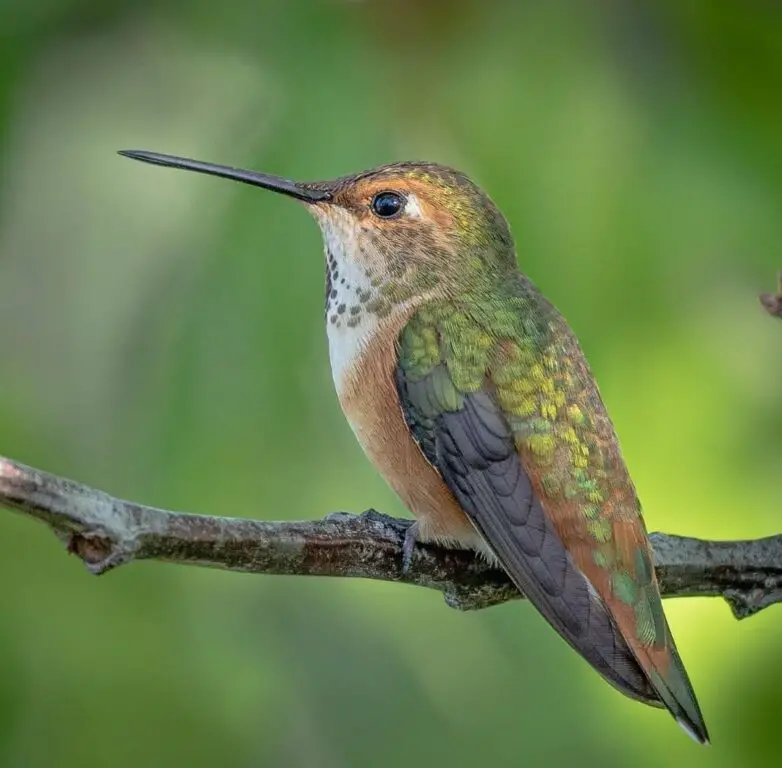
Photo by: Bob Free
It is imperative for bird enthusiasts to recognize that providing a habitat conducive to rest and nutrition goes a long way in sustaining the hummingbirds’ flight and health.
Admiring how fast hummingbirds can fly provides insight into the interplay between biology and physics, a dance of speed and survival that keeps these birds buzzing swiftly through our skies and into our hearts.
The Role of Wing Structure in Hummingbird Flight Efficiency
As a longtime observer and admirer of these remarkable birds, I can attest that understanding how fast hummingbirds fly is indeed a fascinating inquiry. These agile creatures exhibit flight speeds that intrigue many enthusiasts.
To appreciate how fast a hummingbird flies, it is essential to understand their wing structure, which plays a pivotal role in their incredible aerial efficiency.
Read my article: Hummingbird Feathers: A Closer Look at Nature’s Design
Hummingbirds’ unique wings are unlike those of other birds; they have a ball-and-socket joint at the shoulder, allowing them to rotate their wings 180 degrees in all directions. This articulation is what permits hummingbirds to hover in mid-air, fly forwards and backwards, and even upside down – feats quite rare in the bird kingdom.
Discussing how fast hummingbirds can fly, it is worth noting that their wingbeat is incredibly fast and precise, beating about 50 times per second in a normal hover, and can reach up to 200 times per second in a courtship display!
When it comes to migration, some hummingbirds sustain an amazing level of flight efficiency, traveling vast distances without faltering.
Their wings do not merely flap up and down but move in a figure-eight pattern which generates lift both on the upstroke and downstroke, contributing to their quick and efficient flight. This movement is key to why hummingbirds are so adept at flying, as it allows for precision and control that’s paramount for a bird that feeds while airborne.
When measuring how fast these birds fly, one finds that a hummingbird’s flying speed peaks during their migratory sprints, with some species reaching a top speed of around 34 mph (54 km/h). These speeds are astonishing when we consider the relative size of these birds – the epitome of small yet mighty.
The hummingbird’s ability to fly fast is not just for show; it is a critical survival skill that aids them in escaping predators and securing their next meal.

Photo by: IntheWildwithRick
In flight, a hummingbird’s rapid movements may appear quick and spontaneous to us, but there is a highly complex mechanism at play beneath those iridescent feathers. When dissecting the specifics of how hummingbirds manage these speeds one can truly appreciate the marvels of evolution.
Their flight muscles are exceptionally robust for their size, constituting about 30% of their body weight, thus illuminating why hummingbirds can perform such powerful and sustaining flaps.
To witness a hummingbird in flight is to observe a masterclass in aerodynamics. The efficiency of their wing structure is not just a wonder in the context of birds but in the entire animal kingdom.
As we continue to uncover the intricacies of how hummingbirds fly, their astounding speed and agility remain a testament to their evolutionary mastery. Their unique flight mechanics exemplify nature’s incredible design, and there is much more for us to learn from these fascinating creatures that zip through the air with such grace and speed.
FAQs
Q: How fast can hummingbirds fly during normal flight?
A: During their standard flight, hummingbirds fly at an average speed of 25-30 miles per hour. This speed allows them to efficiently travel between food sources and perform necessary day-to-day activities.
Q: What speeds can hummingbirds achieve during courtship dives?
A: Hummingbirds are capable of reaching astounding speeds of up to 60 miles per hour during their courtship dives. Male hummingbirds display these high-speed plunges to impress potential mates, exhibiting their strength and agility.
Q: What is the wingbeat frequency of a hummingbird, and how does it contribute to their flight speed?
A: The wingbeat frequency of a hummingbird is incredibly fast, ranging between 50-80 beats per second in regular hovering. This rapid wing movement is possible due to their unique wing structure, allowing for a figure-eight pattern, therefore both the upstroke and downstroke generate lift. This contributes significantly to their agility and flying speed.
Q: Can hummingbirds maintain high speeds during migration, and how do they conserve energy?
A: Hummingbirds sustain high speeds during migration, often reaching speeds of 34 mph. To conserve energy before these long journeys, they enter a torpor-like state at night, reducing their metabolic rate to save calories for the next day’s flight. They also double their body weight in preparation for their long migration.
Q: How do hummingbirds sustain their energy levels, given their high-speed flight?
A: Hummingbirds possess an extremely high metabolic rate, which allows them to sustain energy-intensive activities such as high-speed flight. They primarily consume nectar for fuel and insects for protein, vital for muscle development. Resting when not foraging for food also helps conserve energy.
Check out my other posts on Hummingbird Questions
Happy Hummingbird Watching!
Backyard Visitors participates in affiliate programs which compensate us for referring traffic.
